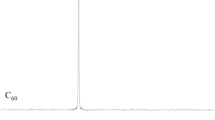Abstract
The decline of the concentration of perfluorochemicals (PFC) after a single injection of three different doses was studied in the circulation of rats. The doses used amounted to 4.4, 10 and 14 g/kg body weight of Fluosol-DA, and emulsion of 7 parts of perfluorodecalin (FDC) and 3 parts of perfluorotripropylamine (FTPA). This also allowed testing of the composition of the emulsion remaining in the circulation and of that found in the liver. After two days a decrease of the half life from 34.0±0.7 to 17.1±4.3 h was found within the circulation at the highest dose. At the same time a change in the composition of the emulsion in the blood stream occurred, favouring the fraction of FTPA. FTPA increased from 28.3±1.4 to 54.4±8.1% on the fourth day. Whereas in the cells of the liver PFC droplets may be broken up, freed from their surfactant layer and handled according to their individual components, for PFC in the blood stream an unchanged composition should be assumed. Both results, the decreasing half life and the change in composition of the circulating emulsion may best be explained by a shrinking and instability of the emulgator film, showing the necessity for development of a superior surfactant.
Similar content being viewed by others
References
Castro O, Nesbitt E, Lyles D, (1984) Effect of a fluorocarbon emulsion (Fluosol-DA) on rcticuloendothelial system clearance function. Am J Hematol 16: 15–20
Chubb C, Draper P (1985) Steroid secretion by rat testes perfused with perfluorochemicals as oxygen carries. Am J Physiol 248:E432–437
Fischer GW, Hunter KW, Wilson SR (1980) Intralipid and reticuloendothelial clearance. Lancet 2:1300–1310
Fujita T, Suzuki C, Ogawa R (1983) Effect of Fluosol-DA on the reticuloendothelial system function in surgical patients. In: Bolin RB, Geyer RP, Nemo GJ (eds) Advances in blood substitute research. Liss, New York, pp 265–272
Krone W, Huttner WB, Kampf SC, Rittich B, Seitz HJ, Tarnowski W (1974) Longterm perfusion of the isolated rat liver. Maintenance of its functional state by use of a fluorocarbon emulsion. Biochim Biophys Acta 372:55–71
Lutz J (1983) Studies on RES function in rats and mice after different doses of fluosol. In: Bolin RB, Geyer RP, Nemo GJ (eds) Advances in blood substitute research. Liss, New York, pp 197–208
Lutz J (1985) Effect of perfluorochemicals on host defense, especially on the reticuloendothelial system. Int Anesthesiol Clin (Boston) 23:63–93
Lutz J, Metzenauer P (1980) Effects of potential blood substitutes (perfluorochemicals) on rat liver and spleen. Pflügers Arch 387:175–181
Lutz J, Decke B, Bäuml M, Schulze HG (1978) High oxygen extraction combined with extensive consumption in rat liver perfused with Fluosol-DA, a new perfluoro compound emulsion. Pflügers Arch 376:1–6
Lutz J, Metzenauer P, Kunz E, Heine WD (1982) Cellular responses after use of perfluorinated blood substitutes. In: Frey R, Beisbarth H, Stosseck K (eds) Oxygen carrying colloidal blood substitutes. Zuckschwerdt, München, pp 73–81
Malet-Martino MC, Betbeder D, Lattes A, Lopez A, Martino R, François G, Cros S (1984) Fluosol 43 intravascular persistence in mice measured by19F NMR. J Pharm Pharmacol 36:556–559
Mitsuno T, Ohyanagi H, Naito R (1982) Clinical studies of perfluorochemical whole blood substitutes (Fluosol-DA). Ann Surg 195:60–69
Naito R, Yokoyama K (1978) Perfluorochemical blood substiutes Fluosol-43, Fluosol-DA, 20% and 35%. Technical Information No. 5, Green Cross Corp, Osaka
Riess JG (1984) Reassessment of criteria for the selection of perfluorochemicals for second-generation blood substitutes: Analysis of structure/property relationships. Artif Organs 8:44–56
Sachs S (1984) Angewandte Statistik. Springer, Berlin Heidelberg New York
Tremper K, Friedman E, Levine R, Camarillo D (1982) The preoperative treatment of severely anemic patients with a perfluorochemical oxygen-transport fluid, Fluosol-DA. N Engl J Med 307:277–283
Vercellotti GM, Hammerschmidt DE, Craddock PR, Jacob HS (1982) Activation of plasma complement by perfluorocarbon artificial blood: Probable mechanism of adverse pulmonary reactions in treated patients and rationale for corticosteroid prophylaxis. Blood 59:1299–1304
Wallenstein S, Zucker CL, Fleiss JL (1980) Some statistical methods useful in circulation research. Circ Res 47:1–9
Author information
Authors and Affiliations
Rights and permissions
About this article
Cite this article
Lutz, J., Stark, M. Half life and changes in the composition of a perfluorochemical emulsion within the vascular system of rats. Pflugers Arch. 410, 181–184 (1987). https://doi.org/10.1007/BF00581913
Received:
Accepted:
Issue Date:
DOI: https://doi.org/10.1007/BF00581913



